Your Ultimate Fenton Glass Guide (History & Values)
[Updated July 2023] Calling all glass lovers! Today we’ll be chatting about vintage Fenton glass, produced for over 100 years in West Virginia (1905-2011), and at one time, the largest supplier of colored glass in the country.
While glassware, especial clear glass, is not selling these days, Fenton still has a market, albeit smaller and at lower price levels than in the 80’s or 90’s. That said, rare elaborate pieces like lamps and pitcher and glass sets still command pretty good money.
But you know what that means? If you’re a collector, now is the time to pick up pieces when you find them cheaply, because the value will only go up.

Collecting Vintage Fenton Glass

Over the years, I’ve bought and sold many pieces of Fenton glass, but only realized recently that I seem to have created yet another “accidental collection.” This time of small vases, including six by Fenton.
I’ve been buying small vases for several years now and have used them for my kid’s dandelion bouquets and other small flowers like violets and forget-me-nots.
If I collect anything, it’s almost always small and contained. I keep the vases in an antique secretary that I inherited from my grandmother.
It has glass doors so I can see my vases whenever I glance into the room.
Vintage Fenton Glass History
In 1905, John and Frank Fenton of Ohio opened the Fenton Glass Company. Initially they focused on painting “blank” glassware. But eventually, they moved to West Virginia, which had the raw materials needed for glass production, and began producing their own glassware–with great success.
Fenton entered the glass market in 1908 with the introduction of what later became known as “carnival” glass. Using Tiffany and Steuben iridescent glass as inspiration, Fenton ultimately produced over 130 patterns of what some have called “poor man’s Tiffany.”
During their 100+ years of business producing high quality glass distributed world-wide, they developed numerous types of glass, including carnival and Bohemian, as well as glass in a myriad of other beautiful colors.
Using gold, manganese, and cobalt, fresh new colors arrived on the market, making Fenton a “truly American product…collected worldwide” (fentonartglass).
It was a sad day in 2011 when the company closed its doors.
How Fenton Glass Was Manufactured
To create any given piece of Fenton art glass, master craftsman would blow molten glass into hand-carved molds. Pieces were then removed after cooling and reheated to allow the artisans to create Fenton’s signature flirty edges or special spouts.
Items like pitchers and baskets would receive hand-blown handles and pieces with more than one part, like cake stands, would be secured together with molten glass.
6 Tips for Identifying Fenton Glass
- Look for a Fenton paper tag, the Fenton raised mark (“Fenton” in an oval), “F” in an oval, indicating another company’s mold was used (1983+). (See below for more info on marks.)
- Fenton produced quality glass, so you should not find any defects like bumps or air bubbles, unless it is a second (look for a star, rose, or block letter “F,” which denotes a second).
- Glass from the 1970’s onward typically contains the “Fenton” mark as described above and seen below.
- Fenton is known for their darling ruffles.
- If you acquaint yourself with genuine pieces of Fenton (through reputable antique centers and auctions) and become familiar with their patterns (through books and catalogs) you will begin to recognize many pieces whether marked or not.
- Get help identifying pieces from old Fenton Glass catalogs provided by the Stretch Glass Society.
Fenton Glass Marks
Prior to 1970, Fenton adhered paper labels to most of its merchandise; unfortunately, they were easily removed and lost in many cases.
And even after 1970, they continued to use paper labels on some of their products. You can find examples of Fenton’s paper labels at this Fenton Glass resource.
Here are four examples of Fenton marks used through the years.

Blue Paper Label (1): Featuring a glass maker with the words “Authentic Fenton Handmade” and dating to 1957 to 1971.
Black & Gold Paper Label (2): Featuring a glass maker with the words “Authentic Fenton Handmade” and dating to 1970 to 1985.
Raised Marks (3 & 4): Featuring “Fenton” molded into the glass, written in two cursive styles, within an oval and dating to 1970-79.
Beginning in 1980 numbers were added below the raised Fenton mark to indicate the year of manufacture:
- 1980: 8
- 1990: 9
- 2000: 0
- 2010: 1
A raised F in a circle indicates a piece made by McKee glass, which bought some Fenton molds in 1983.
Pieces marked with a flame, star, or a block letter F indicate a “preferred second.” Find more info about Fenton’s raised marks HERE.
Fenton Glass Values
The $10 million question regarding most collectibles, is “What’s it worth?” Another version of that question would be “Is Fenton glass valuable?” or “Are people buying even Fenton glass?”
To learn more about values, check out the price guide in my Member Library, which you can get access to when you SUBSCRIBE HERE.
In this post, I’ll be sharing prices I achieved on several of the pieces that I’ve sold in the past. In additions, for pieces in my personal collection, I researched eBay’s sold listings, and included those values here.
In general, glass values have dropped over the past decade and far less people in the younger generations are collecting. Not great news, right? But quality glass like Fenton, made in so many beautiful colors, shapes, and styles, continues to be one of the more popular collectibles.
That said, while it’s not a fast seller, it is a reliable seller, so long as you’ve discovered the appropriate price point for your region of the country and the platform you’re selling on. For example, you may find that you secure higher prices for rarer pieces on eBay, but for more common pieces, in your antique booth.
As with many collectibles, you will likely have to “test the waters” by utilizing a variety of platforms to discover the one that works best for you and your inventory.
Let’s take a look at a few varieties of Fenton glass patterns and colors.
Fenton Glass: Carnival Glass
In 1907, Fenton introduced a reasonably priced line of carnival glass (the first of its kind) modeled after expensive, irridescent Tiffany glass.
They initially referred to it as “Iridill.” Ultimately they produced over 130 patterns(!). Production ceased in the 1920’s, but began again in the 1970’s (through 2011), using the raised italics Fenton mark.

Dragon & Lotus 8 1/2″ Footed Bowl: The beautiful Carnival glass example above was crafted in blue glass featuring fanciful dragons and pretty lotus flowers. It sold on eBay for $70 (2023).
Fenton Art Glass: Cranberry Opalescent Coin Dot

Introduced in 1947, Fenton’s coin dot pattern is highly sought after; the most popular color is cranberry opalescent. Production ceased in 1964.

Coin Dot 6″ Double Crimped Vase (#1456) : This beautiful cranberry vase was introduced in 1948 and discontinued in 1964. An identical piece sold for $30 on eBay (2023).
This vase also comes in honeysuckle and the following opalescents: blue, French, and topaz.
Hand-Painted Ruby Candy Dish

Ruby 8″ Candy Dish: Beautiful hand-painted decoration makes this ruby candy dish a stand-out. Signed and dated 1979 on the back, the same piece sold recently on eBay for $50 (2023).
Unfortunately, I was unable to determine the name of this pattern or whether Fenton made it in other colors.
Note that pieces signed by a Fenton family member typically reach higher values than those without.
Hand-painted pieces can be wiped with a damp cloth (per the Fenton Gift Shop).
Fenton Glass: White Hobnail Milk Glass
Fenton dipped its toe into the Hobnail market in the 1930’s when it created a French opalescent Hobnail bottle for Wrisley Cologne that turned out to be wildly popular.
They based the bumpy pattern on similar Victorian era glass known as “dew drop,” (The Spruce Crafts).
They added the highly successful pattern to their line in the 1939 and collectors fell in love with it.
Hobnail: French Opalescent Vases

Hobnail 4″ Footed Fan Vase (#3953): Buyers love crimped fan vases like this French opalescent piece. Introduced in 1948, production ceased in 1956. It sold not too long ago for $12 (2017).
Fenton’s Hobnail footed fan vase also comes in blue opalescent, blue pastel, green pastel, milk glass, rose pastel, and turquois.
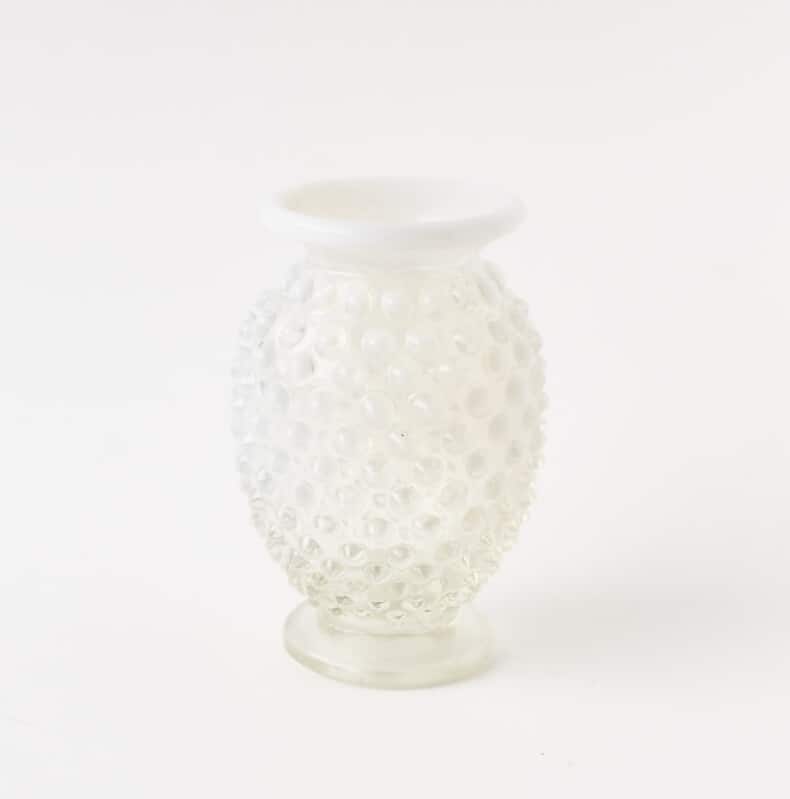
Hobnail 4″ Miniature Cup Flare Vase (no #): This second example of a French opalescent vase dates from 1942 to 1950. It also comes in blue opalescent and cranberry.
Hobnail: White Milk Glass
Introduced in 1950 and produced well into the 1980’s, white milk glass served as Fenton’s “bread and butter” line, according to Bill Fenton.
The 1961 catalog explains that the Hobnail milk glass pieces owe their popularity to the “graciousness and warmth of its timeless beauty.”
Women across the country began collecting milk glass of all types, until it fell out of favor in the late 1970’s. It was not quite as timeless as they thought.
But sometime in the 2000’s, milk glass began to make a comeback; however, values are not nearly what they once were.

Hobnail Double Crimped 4 1/2″ Vase (#3854): This round white Hobnail vase was one of Fenton’s most popular shapes. It currently sells for about $5 in most antique shops.
They also made it in colonial amber, colonial blue, French opalescent, lime green opalescent, topaz opalescent, blue opalescent, blue pastel, rose pastel, green pastel, green transparent, milk glass, orange, peach blow, and turquoise.

Milk Glass Hobnail 4″ Footed Double Crimped Vase (#3952): You can typically find small Hobnail vases like this example at garage sales for a dollar or two and at antique shops for $5-10. Introduced in 1950, it was discontinued in the 1980’s.
Personally, I love the bright white, when filled with sweet flowers like violets and dandelions.
You can also find this vase in colonial amber, colonial blue, blue opalescent, French opalescent, green opalescent, blue pastel, green pastel, rose pastel, green transparent, orange, and turquoise (see below).
Hobnail milk glass owes it’s popularity
to the “graciousness and warmth of its timeless beauty.”
Hobnail: Turquoise Vase

Turquoise 4″ Footed Hobnail Double Crimped Vase (#3952): This vase, a twin of the milk glass example above, bears the raised Fenton in an oval mark on the bottom, dating it to 1970-1979. It sold several years ago for $14 (2016).
You can also find this vase in colonial amber, colonial blue, blue opalescent, French opalescent, green opalescent, blue pastel, green pastel, milk glass (see above), rose pastel, green transparent, and orange.
Hobnail: Blue Opalescent Hat & Vase

Hobnail 4″ Hat (#3991 or 2): This blue opalescent Hobnail hat is also referred to as a toothpick or cigarette holder by some. It sold not too long ago for $12 (2019).
The hat also comes in French opalescent, topaz opalescent, and milk glass.

Hobnail 4″ Miniature Cupped Crimped Vase (no #): You can find this blue opalescent vase, and those in other colors, priced at about $12-14 in many antique malls.
Fenton made it in several of the other opalescents: French, green, and cranberry.
Hobnail: Cranberry Opalescent

Hobnail 4″ Miniature Triangular Vase (#3855): The lip of this cranberry opalescent vase is formed in the shape of a triangle, hence the name. Manufactured during the period of 1940 to 1957, it’s valued at about $12-15.
It can be found in several of the other opalescents: blue, French, and green.
Not surprisingly, this 4″ cranberry opalescent hobnail vase is perhaps my favorite. Collectors adore the pretty pink coloring. When you see the whitish tinge around the neck and on some of the hobnails, you know your piece is “opalescent.”
Forget-me-nots look especially striking in this lovely little vase–see for yourself in this prior post about these darling blue flowers.
But the Fenton 1963 catalog declares, “Fenton handmade planters, vases, and epergnes, are styled for imaginative floral arrangements–but even without flowers, their beauty is very much alive.” Agreed.
Hobnail: Colonial Blue Bell
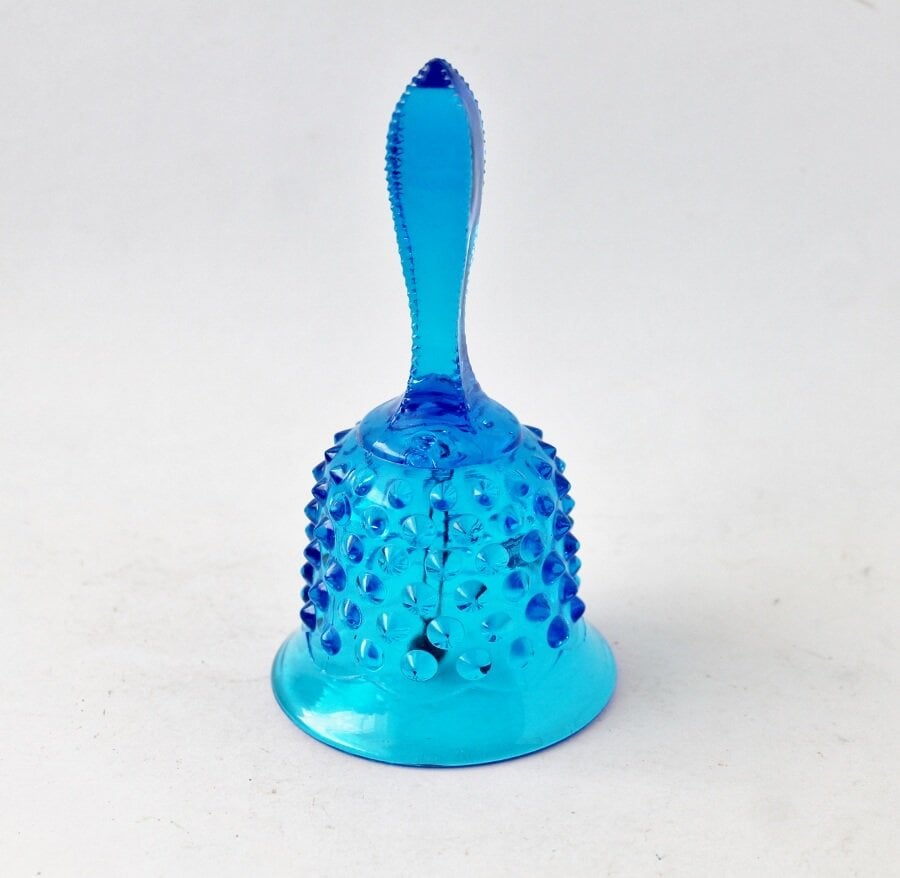
Hobnail Bell (#3667): The colonial blue Hobnail bell was introduced in 1967 and discontinued in 1980. The bell can also be found in colonial amber, blue opalescent, cameo opalescent, milk glass, French opalescent, green transparent, orange, and ruby.
Like the Hobnail kitten slippers below, Fenton’s Hobnail bells appeal to many collectors.
Hobnail: Colonial Amber 6″ Kitten Slipper
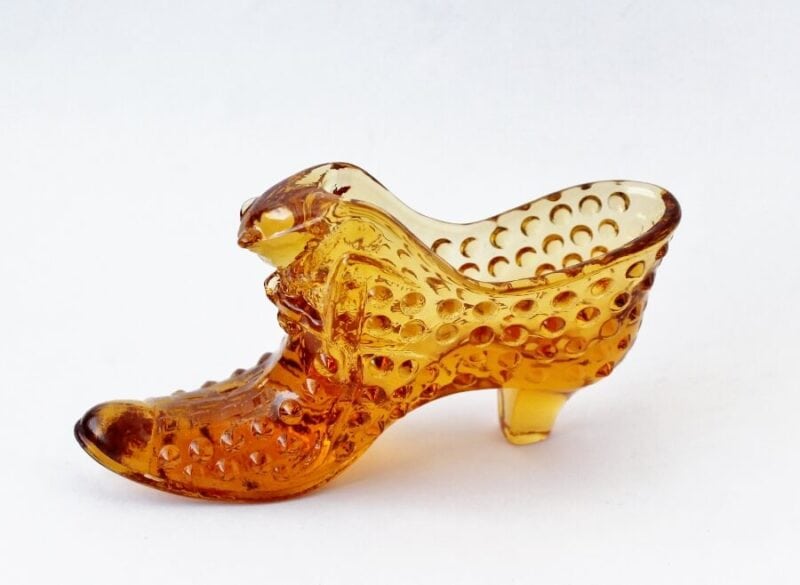
Hobnail 6″ Kitten Slipper (#3995): Made between the 1950’s and 1990’s, collectors love Fenton’s kitten slippers and will spend $10-20 on each.
The Colonial Amber example above dates to the 1962-1980 time period.

Fenton made the slippers in a large variety of colors. You can see six colors in the above catalog page from 1967: colonial amber, colonial blue, colonial green, orange, colonial pink, and ruby.
Fenton Glass: Crest Pattern
In 1939, Fenton began to focus on its “Crest” pattern. These (primarily) milk glass pieces featured ruffled edges with 1/4″ clear or colored trim.
Fenton Fanatics provides a list of all of Fenton’s glass colors. By looking for the word “Crest” in the description, you can establish the many colors Crest can be found in.
Peach Crest
Peach Crest pieces feature pink glass “cased” (enclosed) by white glass. Clear trim was then applied to the frilly edge.

Introduced in 1940 (and replacing the Peach Blo line) this beautiful glass came in all sorts of shapes and sizes.
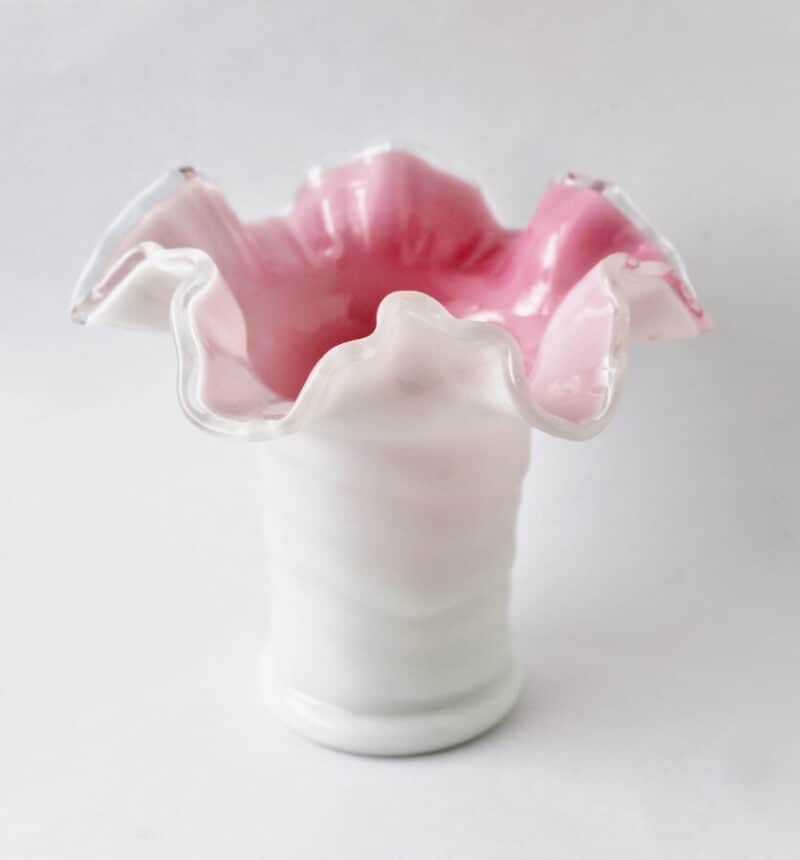
Peach Crest 5″ Double Crimped Vase: Produced for just a few years from 1940 to 1943, this vase is listed in my Etsy shop.
Silver Crest
Introduced in 1942, Silver Crest grew to become Fenton’s most popular Crest line. It features a milk glass body with a clear glass trim.

Low Footed Silver Crest Comport (#7329): Without knowing its official designation, I would likely call this dainty 3 3/4″ high piece a candy or nut dish (1954-78). I’d value it at about $10-12.

Silver Crest 4 1/2 Double Crimped Vase (#7354): Hand-painted pieces like this sweet little vase, covered with pretty roses, are a bit more desirable, especially those in perfect condition.
See special washing instructions below.

Silver Crest 6 1/4 Fan Vase (#7357): This hand-painted vase with “violets in the snow” decoration dates to between 1970 and 1971. It sold on Etsy for $26.99 (2014).
See special washing instructions below.
This post contains affiliate links for research materials related to this article. This is both for your convenience as well as to support this website, as I receive a small compensation whenever you click on such a link and make any sort of a purchase, for which I thank you. See my full disclosure here.
“Fenton’s handmade planters, vases, and epergnes,
are styled for imaginative floral arrangements–
but even without flowers, their beauty is very much alive.”
Rose Crest
Fenton initially manufactured the Rose Crest pattern for another company, Weil Freeman. Because of its popularity, they began producing their own line for two years short years: 1947 and 1948 (Fenton Art Glass Patterns 1939-1980).

Rose Crest 5 1/2″ Double Crimped Bon Bon (#7225): Fenton refers to pieces with pink trim as Rose Crest. This bon bon sold a few years ago for $8.99 (2018).
Vintage Fenton: Persian Medallion
Fenton offered carnival glass in the Persian Medallion pattern for sale from 1911 to 1924, (Carnival Glass Worldwide). They reissued the pattern in additional colors in 1970.

Persion Medallion High Footed Double Crimped Custard Comport (#9223): This 6 1/2″ custard comport dates to 1972-79.
Because the company manufactured its custard glass using uranium oxide, it will glow green under ultra-violet light, which makes it more collectible.
 Here’s a closer look at the Persian Medallion pattern and the 1970-79 Fenton mark on the bottom of the base.
Here’s a closer look at the Persian Medallion pattern and the 1970-79 Fenton mark on the bottom of the base.
Vintage Fenton: Daisy & Button
The company introduced the Daisy & Button pattern in 1937 for two short years and then reintroduced it in 1953. They produced it into the 1990’s.
Daisy & Button: Milk Glass Boot
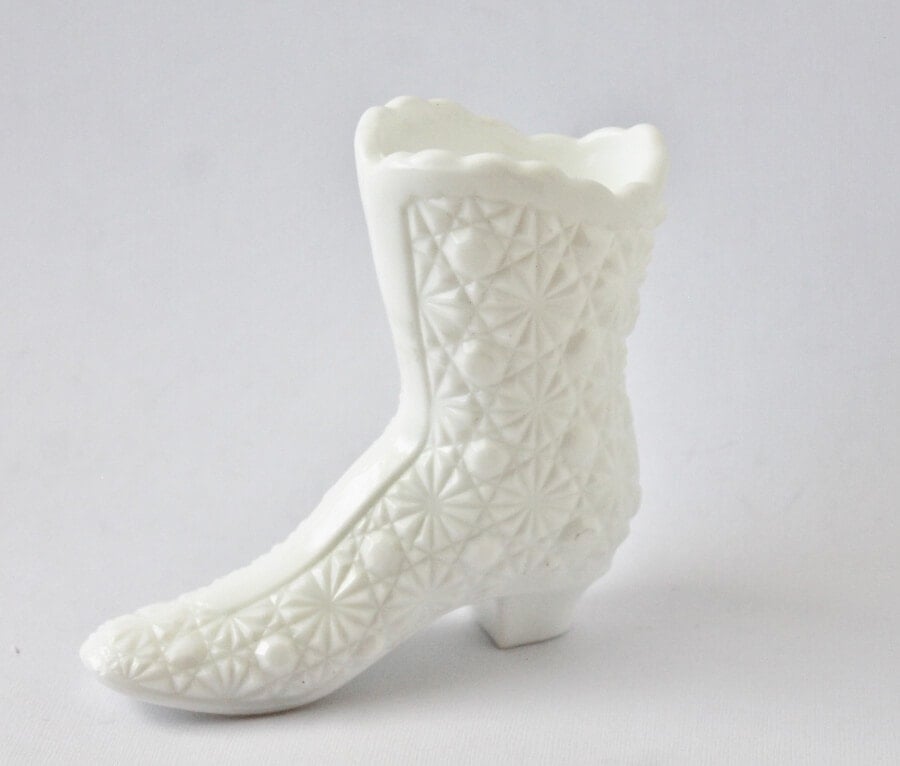
Daisy & Button 4 1/2″ Boot (#1990): Fenton introduced the Daisy & Button milk glass boot in 1967. Production ended 1975. Most boots sell on eBay for about $10-12.
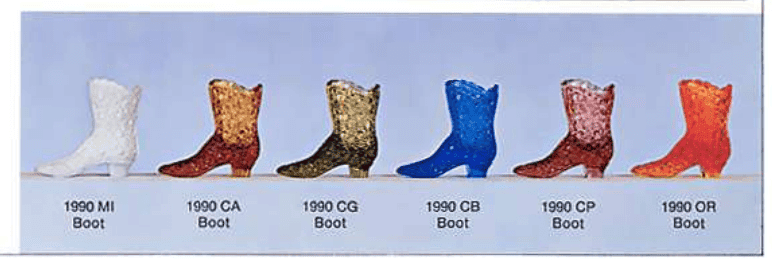
Here you see part of a 1967 catalog page, featuring the Daisy & Button boots in a variety of colors: white milk glass; colonial amber, colonial green, colonial blue, and colonial pink; and orange.
It also comes in blue satin, carnival, custard, lime sherbert, and orange carnival.
Daisy & Button: Milk Glass Oval Basket

Daisy and Button Oval Basket (#1939): This milk glass basket with a split twig handle has retained its gold and black Fenton paper label with a glass worker, which dates it to 1970-1985.

Here’s a 1965 catalog page showing the oval basket (#1939) in the five different colors you can find it in: colonial amber, blue, and green, along with orange and white milk glass.
How to Clean Fenton Glass
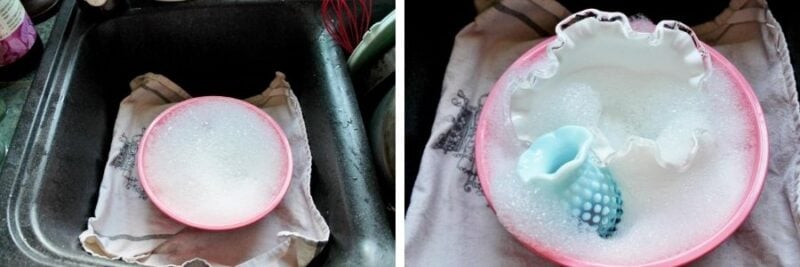
You can wash Fenton glass pretty much as you would wash any other kind of glass: with soap and water. Squirt some dish washing liquid into a bowl and add warm water. I place mine in the sink with a towel underneath to avoid breakage.
Let the glass soak for a bit if it has stubborn grime stuck to its exterior or interior surface.
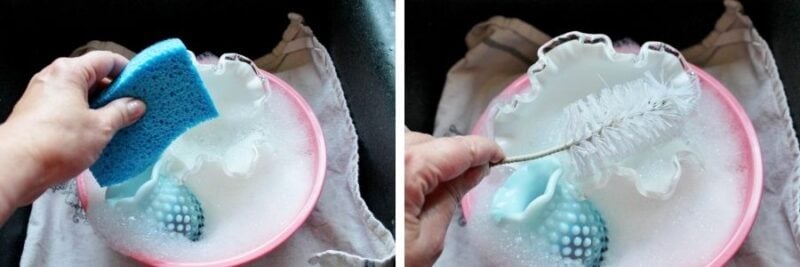
Feel free to use the scrubby side of your sponge to help remove anything adhered to your piece. It won’t scratch the glass.
For problem areas (like between hobnails or inside intricate designs) and in tricky interior spots (like the very bottom), use a bottle brush, tooth brush, or any other kind of brush to clean the glass.
Regarding hand-painted decoration: After the application of any hand-painting, Fenton glazed and re-fired most, if not all of these pieces. For cleaning, the Fenton gift shop recommends using a damp cloth if nescessary.
Conclusion
I hope you enjoyed reading about vintage Fenton glass and seeing some examples from my collection (and from previous sales). Find more resources HERE.
How about you? Are you a Fenton lover? Collector? I’d love to hear about it in the comments below!
If you enjoyed your visit, I hope you’ll subscribe and never miss a post.
You’ll receive access to my MEMBER LIBRARY and get loads of FREEBIES!
Sign up and get TWO FREEBIES:
(1) A one-page GUIDE TO COLLECTING Fenton Glass &
(2) A Fenton Glass PRICE GUIDE
Bye for now,





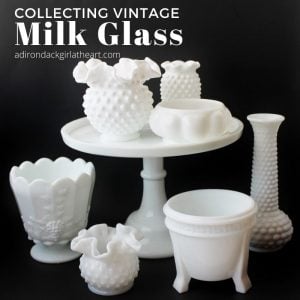
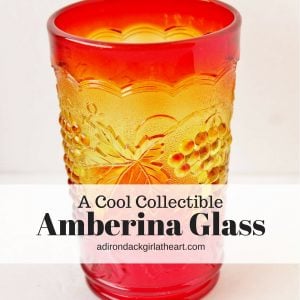


I have one piece of fenton that I received as a wedding gift in 1956. I have lugged it (wrapped carefully) with each move and I still have it. Beautiful blue basket with a handle. Still love it as much as when I received it. Thank you for all the information. Love all your posts. God bless
I imagine there are quite a few Fenton pieces at the estate sale down the street from me. It was an antique store forever, but the owners have passed and the kids are now selling. It’s going on 4 weekends, then an auction takes over. If you’re in the area, Diana…… https://www.estatesales.net/TX/Castroville/78009/2265780?utm_source=sbcglobal.net&utm_medium=email&utm_term=78009&utm_content=San-Antonio-TX&utm_campaign=2019-07-01-1PerWeekOnMonday
OMGosh, I would have LOVED to have seen this sale. I bet it was fanstastic! I live about a 3-hour drive from Castroville……totally worth it to find some treasure! 🙂
Diana, my I have loved Fenton Cranberry glass for years and have quite a few pieces–most given to me as gifts from my dear mother. I don’t have much display space in my house so they are packed away so other collections could have a turn to be shown.
I will get them out again and be glad to see them and display them again. In fact, I have been thinking about doing that recently. I enjoyed your post on this most lovely glassware.
I have collected Fenton for years. Started out when my mother-in-law passed in 1967 and I inherited some pieces. Love them all. So very pretty.
Hi Susan me too! Thankfully my stepmother loved garage sales and estate sales hoping to stumble upon people who didn’t know the value of what most called the “gaudy junk my mother kept” so since I was a wee one I had no clue she was truly prepping and training me for the moment I met my mother-in-law and her and I bonded over antiquing and became such great friends!
I ended up inheriting some divine pieces, pieces we collected and bought on our lady day outs. I can’t help but smile every time I glance over and see a memory. She would share the stories of how she acquired such and such piece, or she herself inherited. I miss her so very much. I miss my friend.
I’ve been trying to resist my attraction to old glassware when I’m thrift store shopping but now I’m going to be checking to see if any of it is Fenton glassware.
I love Fenton hobnail but also collect whatever milk glass I can get my hot little hands on reasonably. I finally got one of my “Holy Grail” pieces 2 weeks ago–the Westmoreland swan on an oval dish. Prob reasonable market price, but it was a lot for me! Poor thing is blind, though; I need to look up on line to see what kind of eyes she should have. I had discovered glass fishing lure eyes @ Cabelas; they are so much classier than the wiggle eyes I saw glued on one cat on a basket piece! I have several pieces of blue and white slag, custard, and blue satin Fenton, too; never could have enough! Have a lot packed in boxes; someday it will be properly displayed! Great post, as usual!
I always love to read buying guides and histories of glassware. When I saw that you had posted this at Tuesday Turn About, my heart fluttered a bit, and I waited to read it until I could really enjoy it! Thanks for sharing your collection! I’ve inherited some lovely milk glass from my mother, and they sit on the top of my Hoosier cabinet!
What a great, super-informative post. I love reading the history…..I remember my mom having a few hobnail milk glass pieces when I was growing up. Not sure what happened to those pieces but I have collected a few myself over the years. And if you can believe it my Dollar Tree is selling hobnail clear glass vases lol You can bet I bought a few:) I also recently purchased a large hobnail pitcher from Antique Farmhouse and hobnail tumblers from Big Lots. Just don’t tell my husband. Thanks for sharing at Vintage Charm. xo Kathleen
I have collected the Fenton small statues for a long time now. For instance, a fish, a mouse, a rooster, a first communion girl,…..I never see these items anywhere. Are they worth anything today?
Recently I just purchased a white milk glass Fenton vase. My daughter collects vases. She loved it.
Hi there! Unfortunately I’m not familiar with the Fenton figurines. I just added some links to some Fenton guidebooks that might be able to answer your questions. Alternatively, you could look for the books in your library or bookstore. What a blessing that you and your daughter share a love for beautiful glassware 🙂
Hi all, so I just found this post thru Google . I have loved everything Fenton since I was 11. I had three paper routes when I was that age and would go to the family-owned hardware store where the owners daughter would sell Fenton ware.
I have since then gifted most of it until, the passing of my beloved Mother in 2018. I was trolling Facebook garage sale and found a man selling a whole lot of glassware. He stated he bought estates. Much to my surprise he had purchased a lot of blue opalescent glassware. There were 120 pieces for 75$. Well me being the frugal person I am got him down to sixty dollars.
I got 45 pieces of Fenton blue opalescent hobnail. Now I collect what I can find for a deal. I also collect milk glass hobnail. I can’t wait to join the Facebook page for this group! Thanks for letting me share my story.
Hi Marianne! Your comment slipped through the cracks 🙁 LOVE your story of how you started buying Fenton. You were certainly determined, what with three paper routes!
What an amazing deal you got on all those pieces–50 cents per piece!! Sounds like you have an outstanding collection. I’d love it if you’d share some photos over in the Facebook group (Your Vintage Headquarters) 🙂
Hi Diane – stumbled across you while researching prices for a Fenton collection left to me by my late Mum. Wow, you are a wealth of knowledge and I so appreciate you sharing so much! I’m having SUCH a hard time deciding if I can REALLY part with it?! It’s so lovely and these were just a few of her treasures. But, at some point space becomes an issue and the younger generation has no interest in it. God bless. Warmly – Teri
Hi Teri–so glad you “stumbled across” me and my blog 🙂 I hope you’ll find other topics of interest. You might be enjoy joining my Facebook group (Your Vintage Headquarters). We would all LOVE to see photos of your Mum’s Fenton collection. God bless!
In the section on colored hobnail, in this wonderful post above, you have a picture of a lovely 4” fluted vase in cranberry and one that you refer to as aqua or aqua blue.
I am wanting to start a collection of these adorable small items in aqua, (vases, oil & vinegar mini cruet, individual cream & sugar, mustard, etc, ). While the items are typically referred to in various online sites as “opalescent blue” the colors in the online photos varies between what I consider aqua and blue.
So I’m wondering if these items were made in both colors (blue and aqua blue) or is it just the photo lighting? It’s hard when shopping online to trust photo colors and the color names. Also, is there a book you would recommend for a beginning collector? Thanks so much!
Hi Lizzie! I’m so glad you enjoyed the post. Fenton produced glassware in many shades of blue, partly owing to the fact that each piece was handmade (mostly using molds).
And yes, sellers refer to them in all different ways, unfortunately. The only way to be sure when buying online is to contact the seller and explain the color you’re interested in and ask does their item fit the bill.
If you pop back to the blog post and scroll down to about the middle, you’ll see some guidebook recommendations 🙂 When you buy on one of them, I receive a tiny commission!
Come back soon 🙂
I collect and sell Fenton and would just like to say that there are many good Facebook pages with very knowledgeable people that will help anyone who wants information about Fenton. Some of these pages have auctions and sales, and others help with identifying information or selling inherited collections. The best advice is research, whether buying or selling as it helps with your knowing the value of what you have.
Something else I would like to pass on is the ultra violet factor in certain colors of glass that has had a surge in interest lately. Certain colors of glass are UV light reactive due to elements used in their production, including custard, Burmese, topaz, key lime, and green apple. These are Fenton colors that glow under UV light.
Glowing UV glass is scarce due to the restrictions on spent uranium which is needed to make the glass glow. And no, it is not in any way shape or form hazardous! (Unless you eat it, LOL.) Thanks
Thanks for the info about Fenton FB groups and the reactiveness of some Fenton to UV light, Ken. Always so good to have more info on these vintage and antiques that we love 🙂
Thanks so very much for the good info about fenton glass pieces.I have a few pieces.I recently found a beautiful vase at a second hand store, its light green iridescent glass with white and v
I’m so glad you enjoyed the post Brook! Sounds like you found a dandy piece!
So in my middle years, I have developed an insatiable appetite for the Fenton Hens on Nests. I have about 10 variations of Milk Glass chickens, an olive green one and a cobalt blue one. Always looking for more, craving a red one and the iridescent ones. What would be good online places to purchase (besides eBay)?
Thanks for the article!
I would look on Etsy and on RubyLane as well, Angela. Sounds like you have quite a collection going! I’d love it if you’d share photos and background info on them in my Facebook group–Your Vintage Headquarters. In addition, you can let other members know that you’re looking for more to purchase. Buying and selling is discouraged in the group but you can make that announcement and if anyone has one to offer, they can message you directly. Good luck!
Hi Diana and group. Anyone seen hobnails on the INSIDE of pieces? I inherited a bunch of glassware, and one of my favorites is a quart sized pitcher and six tumblers of opalescent glass, and all have hobnails on the inside. Pretty, but I like to use my antiques, and these are really hard to clean after serving lemonade in them. Any info would be appreciated. Thanks.
I enjoyed reading your information as I am John W. Fenton’s Great Granddaughter. Needless to say my Fenton collection is quite extensive with many, many signed pieces. Some of my fondest memories are going to the plant with my Grandmother Nellie Fenton Glasgo and having lunch with Frank Fenton,
I’m so glad you enjoyed the post Valerie!! It’s an honor to have you visit and leave such a lovely comment 🙂 I can only imagine the amazing collection that you must have. What special memories of your grandparents–that makes me smile. One of my favorite people in the whole world was my own grandmother.
My mother passed many years ago. She left me a beautiful opalescent blue hobnail candy jar that I always wanted to know more about. I was so please to find a photo of it in the 1963 catalog that you posted and now know the name of the company who make it! Thanks for sharing!
You’re so welcome Lori–glad I could help 🙂
This was a lovely article Diana. I am not a Fenton collector but about twenty years ago a family friend gifted me a pale lavender Fenton vase, she claimed it was from the late nineteenth-century. Off and on since then I have tried to determine its age but whenever I googled “Fenton lavender vase” the results would be carnival glass which doesn’t match my opaque vase.
Today from your article I finally learned that it is called satin glass, thank you! Now I know my vase is a satin glass melon style vase. It doesn’t appear in any of the old catalogues you linked and the only date I could find online suggests a 1970s date of manufacture so a lot newer than I had been led to believe!
The Stretch Glass Society has a second set of Fenton catalogues up, covering 1970 to 1989 here: https://www.stretchglasssociety.org/fenton-catalogs-70s-through-80s
I’m so glad my article helped you get to the bottom of things Carina! Thanks so much for giving us a link to additional information 🙂
I enjoyed reading your article. I received a Fenton lamp with a glass hand painted globe from my late husband in 2000. The globe recently got broken and I desperately want to replace it. I have searched and searched. Do you know of any resource where I might find a replacement?
Thank you
Kathy
Gee Kathy I don’t 🙁 My only suggestion would be to check eBay and Etsy regularly to see what you can find. A Fenton collector’s group would also likely have some ideas for you and perhaps know of someone who deals with parts. Good luck!
Join some Fenton Facebook Collector groups. Many of them sell Fenton. I am a member of Fenton Glass Collectors and Fenton Lamp Collectors on Facebook. 🙂
Thank you for all the info! I recently handed me down a Fenton Yellow Stain Custard Rose Glass Compote Candy Dish. There is a brown “Authentic Fenton Handmade” sticker on it and I was wondering if having the sticker is more valuable than not having one? If so, how valuable is it? Thank you for your time!!
You’re welcome Yuki! As far as the sticker goes, it might add a few dollars to the value. It would certainly give confidence to new or uncertain collectors that what they’re buying is in fact Fenton. I wish I had a more definitive answer for you. I’d check eBay’s sold listings and see if those with stickers are doing better than those without.
It’s simply a matter of preference. Some people like their pieces to have the labels, some don’t care. Since the labels were glued on, many either fell off or came off when the owner washed them. Personally, I like to find Fenton with the labels still attached, but I won’t keep from buying a piece if the label is gone 🙂
Hi, I’m so glad I found you. I have a small group of hobnail open salt dishes. I have aqua ,clear, green and a very dark green. Now for the Question… I was at my neighbors one evening and she has two master salts.
I’m sure one was light pink and one was red. Did these salts that are 3″x3″ and hobnail come in those colors. We both moved and later I learned she passed. I been looking for a least 25 years . Maybe I was dreaming? martha
Hi Martha! Thanks for dropping by 🙂 Unfortunately, I’m not that familiar with Fenton salts. Luckily there are a number of Fenton guidebooks out there (I linked to a couple in the article), some of which may be in your public library. Additionally, if you search Google for Fenton catalogue (+ a date, like 1940), you may find your answer in one of those. Good luck!
Hello. I came across your website while researching Fenton glass. I have a few vintage pieces and will be receiving more from my parents as they are downsizing their collections. I have 2 beautiful pieces – a pink and white basket with a clear gold handle and a pink ombré vase with a clear wrapping vine. Both purchased by my grandparents prior to 1960 so neither have the Fenton sticker. I know they are authentic but do you know if there’s any other way to confirm authenticity? Thank you! Suzanne Elizabeth
You can find many of Fenton’s original catalogs online. You could search them for your pieces. Additionally, there are numerous guidebooks on Fenton glass (some linked in this post) that would also be able to help you. Check your library or bookstore for one or more of those books. There’s probably a Fenton FB group that might be able to help you confirm the identification as well. Good luck!
If your one item has applied glass to the outside of the piece (called rigaree), this is something that was never done by Fenton. Pictures would help 🙂
Thank you so much for this page, it has been more than helpful. I came across a Fenton hobnail pitcher in a pile of rubble after hurricane Ida. It has two makers marks on the bottom. One is in the middle and the other is slightly larger and off to the side. Have you seen that before?
Thank you kindly-Nikki
Hi Nikki–what a find! I’ve not come across any pieces with two marks, but accidents like this happen occasionally with all sorts of collectibles. I’m thinking it would neither add nor detract from the value of the piece but it makes it interesting, right??
Sometimes the logo didn’t strike well first time, so they tried again. On some pieces, they can never get it to strike correctly.
Thank you for posting this very informative and interesting page about Fenton! Learned so much and now even more interested about collecting. I only have 2 pieces from family. Ready to find more!
Thanks so much for the clarifications Linda (and your kind words about my ideas) 🙂
Yay! I’m so glad you enjoyed the article Regina. Best of luck with your collection 🙂
I have a piece that my late husband bought me years ago. I have searched and searched with no luck trying to find out details about it. It’s a Hippo with bibs and a basket of apples in front of it. It has a signature of Hughes on the bottom and numbers 92/100 also on the bottom with the Fenton sticker on it. Does anyone have any idea what the details are on this piece? I would greatly appreciate it!
Thanks,
Mary
I’m not familiar with that piece Mary. I recommend joining a Fenton Facebook group and posting some photos there. I bet they’ll be able to help you out 🙂
Hi Diana! Great site and great info. I have two small Fenton Flame orange glass plates, there is a very old label on the bottom that is handwritten “Fenton Flame pattern, 1930s, very rare.” I purchased it at a charity thrift shop that tends to know what they have and price it accordingly. They’re beautiful but I cannot find any info anywhere on them. Thought I’d see if you or anyone reading this has come across this glass ware. Thanks!
Neat finds Anna! I’m not familiar with that piece but as you said, perhaps another reader can help you out. You could also check the library or bookstore for a Fenton guide and see if you can find it in there 🙂 Best of luck!
Hi, I recently came into three pieces of Fenton glass. A bud vase, a narrow neck vase, and a skinny vase. The have a handwritten tag on the bottom: John Fenton and a N.Y. address.
They are hand blown with a dark glass with three colors stretched through-out. I can provide pictures if interested! Supposedly they were purchased directly from John before Fenton glass company was even in business. I am wondering how to verify this info or have them checked out. Not like any Fenton glass I have ever seen, so any info would be greatly appreciated!
They sound fascinating Timothy. The best thing to do is post photos in my Facebook group, Your Vintage Headquarters, and Fenton lovers in the there will help if they can. Alternatively, there are probably Fenton-focused FB groups that would have in depth info for you. Good luck!
Like so many others, I stumbled across your blog by searching for Fenton art glass. I have a tall 4-paneled, ruffle edge vase in a marigold color. I don’t know if it’s Fenton or Imperial Glass. I have a booth but I rather like it myself. I have several other pieces of Fenton, one in particular which is priceless to me. A white hobnail milk glass vase, ruffled edge, that my husband gave me on July 29, 1966 for presenting him with our daughter! It had a dozen pink sweetheart rose buds. It’s going to my daughter; she loves it as well as white hobnail and other milk glass pieces. Thank you for great information.
Oh my gosh what a sweet story Sharon! Thanks so much for sharing it with us. What a truly meaningful heirloom for your daughter to inherit one day 🙂
I have two Fenton Christmas Cats in white satin. One is sitting, licking her paw with a scarf & had some painted flowers. The other is curled up, sleeping with the painted flowers. My question is, “Is the satin Fenton made from animal bones ?” Although I love the two Fenton items, I am a vegan and it disturbs me that I may own these two beautiful Fenton pieces if they are indeed made of bone.
Thank you. Joan
Hi Joan. Your pieces sound lovely. As far as I know the only ingredient, other than paint, in Fenton Art Glass is glass.
My father, Isaac Willard, Jr. was the head glass chemist for Fenton from 1950 until his untimely death at 48 years old in 1973.
A clue to indicate the age of the milk glass pieces (without a mark) is to look at the color of the glass. Older pieces will not be as stark white as newer ones. Fenton was already producing milk glass when my father began working there, but he perfected the stark white color that you will find in later pieces.
Also, custard and Burmese glass utilizes uranium to produce the yellow color. Uranium glass is highly collectible today, so if you own any of this glassware, keep in mind it’s elevated value.
Sandy Willard Barrett
Oh my gosh Sandy–you are such a wealth of information about Fenton glass. Thanks so much for sharing your expertise with us; it’s greatly appreciated!
Hi Diana,
I think I have some of the white hobnail milk glass pieces – but I have one Victorian-style antique cobalt blue glass lamp (ruffled, open top) and I cannot tell if it’s Felton or not. It may be depression glass, but I just can’t seem to find anything about it online.
If I sent you a photo, would you be able to help identify?
I’m mostly interested in just knowing what I have – so much was left to me when my grandparents passed – most of it is either Victorian Style, Early American, and some Mid-Century.
Thank you in advance!
Hi Kallie–due to the very high number of requests, I’m unable to appraise/evaluate reader collectibles. I have however written an article that identifies 9 free ways to price/identify your vintage and antiques. You can read it here: https://adirondackgirlatheart.com/9-free-ways-to-price-antiques/
Hello, greetings from Indiana….. I have several red Fenton pieces, including vases. I haven’t seen much written about the red pieces. I even have three red Fenton lamps, (purchased in the 1980’s) and I haven’t found any information regarding them at all. I’m not looking for dollar value since I’ll never give them up 🙂 but just curious as to why not too much information is available about the red items and most especially the lamps. Thank you. Janet Doyle, Mishawaka, Indiana
Hi Janet–I wish I had an answer for you. I will say that there are numerous Fenton guide books available, many by date range, so I bet you can find one that covers the 1980’s. In addition, there are numerous Fenton catalogs available on the internet that may provide a bit of info. Best of luck!
The artists at Fenton Gift Shop always fire their glass “after” applying hand painted decorations. It is recommended to clean Fenton Art Glass with a damp cloth when necessary.
Thanks for the info! I’ll update the post.
I’m wondering if you live in or near the Adirondack Park as I do and would love to have someone look at my Fenton collection. I grew up just a few miles south of Williamstown in Vienna, and my family collected Fenton for years. I also knew a young woman who painted there for a time. I have a small collection which I always thought one of my daughters or granddaughter would want but they have no interest. So, I guess I may as well start parting with these pieces.
I live in far western Fulton Co., Town of Stratford, and would love to bring my glass for an appraisal. Do you do this or know of someone who does?
Thanks Much for Your Time,
William Marsh
Hi William–though I learned a lot in writing this article, I’m not an expert by any means and would not be able to appraise your collection. I recommend talking with the owner of a reputable antique shop who may have a recommendation for you. Or contact a reputable auction house for suggestions. Best of luck!
Thank you for creating such a wonderful guide. As a young child, I remember my mother buying various pieces of Fenton Glass. My mother recently passed. As I work through items stored, I remembered the pieces but didn’t know their name/Fenton until finding your guide. Reading this made me feel even more connected to my mother. As a child mom knew what Fenton was, in the 1960’s. Now I know, thank you again for your beautiful work.
You’re so welcome Frank! So sorry to hear about the loss of your mother, but glad I could be of help.
I have a lot of silvercrest. I want to know if I can put it in the microwave oven
A Fenton collecting group (I’m sure there’s one on Facebook) would be the best place to ask that question. My gut tells me no-
Hello Diana, we have several glass collectors in my family due to my great grandfather working for the Hazel Atlas company for 50 years. My mother has given me many beautiful pieces over the years including several Fenton items. I’ve been adding a few to my collection but just a few… Thank you for the wonderful information. I’ve really enjoyed the history lesson!
Yay! That makes me so happy to hear Leslie 🙂 Sounds like you have a wonderful collection-
Hi all,
I just bought my first piece of Fenton for a 70th birthday gift for my best friend. She’s from Ohio and is an artist, so I know she will appreciate the gesture. It’s one of the uranium jars with the painted log cabin scene on custard, signed by the painter and has the black and gold seal, 6” x 6.” I paid $85 for it and even if that’s a little high, it’s a local piece I picked up on marketplace.
I’ve tried to find out more about when this series was produced and any other history, or a book that has a section dedicated to this line, and am missing the mark on how I’m searching. I’m hoping I’m in the right place to be pointed in the right direction. Thank you in advance if anyone has some knowledge to share that could help me.
Thank you!
Sounds like a beautiful piece Lisa. Use this link (that I provided in the article) to determine the date range on the piece, then go to the bookstore or library to find a Fenton guidebook for those dates. There are loads of Fenton guidebooks out there — old and new.
Alternatively, use eBay’s camera function in its search bar to take a photo of your piece in the ap (or simply describe the piece in the search bar) and then read the descriptions of any pieces that show up. Some sellers provide great info relating to history and dates. Best of luck!